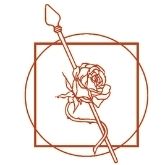Chaturvarna in the Veda and the Circle
‘Chaturvarna (four-fold structure of society) has been in a process of fragmentation for several thousand years; the whole, composed of its well defined parts has been lost sight of, the quality which describes its purpose and reason for being – integrality – has disappeared’. (Thea, Culture and Cosmos, The Vishaal Newsletter, Vol 6, no 3, August 1991). Deprived of a ‘centre that holds’, that acts as an integrating force for society, Hinduism has lost its singlemost element for binding the nation.’ (ibid, Vol 6, no 4, October 1991).
While other great civilisations of the world have waned, the Indian nation has had an unusual capacity to endure. The key to this has been their connection to the cosmic harmonies. The origin of Chaturvarna stems from the same cosmos, it is the expression on earth of those harmonies. Is this relationship only symbolic? Or more?
‘As above, So Below’: this ancient dictum holds that the microcosm is equal to the macrocosm., i.e., the human being is a mirror of the cosmos. Our planet is one whole. Its major pattern of division is the four Cardinal Points of the Earth and similarly the human being is one, composed of four layers of consciousness, physical, vital, mental and supramental.
It is not a surprise that the astrological symbol of our earth is the circle divided into four.
One of the oldest references to Chaturvarna is the Purush Sukta, which describes the Universal Being: all parts of creation emerge from or find their place in this being. The Ancient Fathers had this fourfold consciousness of our Earth to a high degree, their vision of Varna arose out of this.
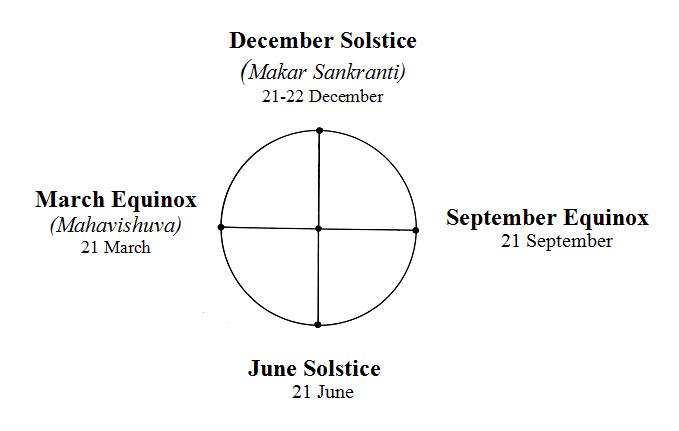
First they describe the body of Man, divided into four quarters, three of these are ‘above’.
All beings are a fourth of him,
Three fourths are the immortal in heaven
Three fourths of the Purush ascended high
One fourth took birth again down here.
From this he spread in all directions
Into animate and inanimate things.
Using the Purush as their oblation,
The Gods performed the sacrifice.
Spring served them for clarified butter,
Summer for the fuel, and autumn for the offering.
The description of Chaturvarna (Purusha Sukta RV 10.90.11–12) comes several verses later:
When they divided Purusa, how many portions did they make?
What do they call his mouth, his arms? What do they call his thighs and feet?
The Brahman was his mouth, his arms the Kshytria made.
His thighs became the Vaishya, from his feet the Shudra was produced.
Caste was in no way hierarchical for the ancient Rishi; in the above verses the divisions are based on ‘function’ of each of the ‘portions’ of Purusa, i.e., what can the Brahmin, the Kshatriya, the Vaishya and the Shudra DO, what is the function of each part in the ideal society? The four-fold cosmic harmonies became the model for the system of Varna, not just by chance, Thea writes, (Caste, Culture and Cosmos):
‘…these are everlasting indestructible pillars of our planet’s journey around the Sun, and most ancient societies honored these pillars in one way or another’.
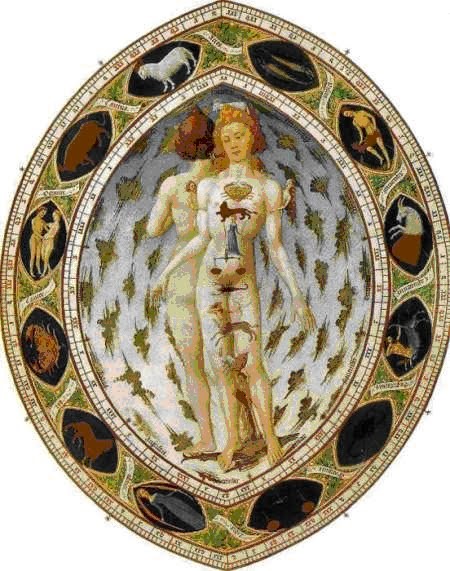
Zodiacal Man in Très Riches Heures de Jean de Berry, 1413–16
This Medieval drawing, showing which zodiacal signs rule each part of the body, can also explain the reason why the Rishi described caste as they did; it is equivalent to the Vedic Cosmic Parush (Thea, Origin and Nature of Hindu Decline, 2006). It is the same circle that can be divided into four quarters as per the Equinoxes and the Solstices to give us our Cosmic year of Time or divided into the Cosmic Purush, out of which caste is born.
Caste had nothing to do with status. The hierarchy of caste and the condition of ‘outcaste’ crept in over time; they are societal issues, not spiritual issues, a degeneration or dysfunction slowly replaced the Rishis’ original consciousness of unity.
Today, issues of Castism are being compared to other world wide ‘isms’, problems of Race and Gender as well. Thea never advocated for a re-instatement of the Caste System. She saw it as a symbol of ‘dysfunction’, and not the only one (see Theme Three on the Hindu Calendar for Temple timings).
With Thea’s Indocentric Cosmology, the new focus on this issue becomes:
l. How did a degeneration set in that shifted Varna from a vision based on the Earth’s fourfold harmonies to a hierarchical system based on status?
2. What is the built in system that ensures a renewal and updating of the Indian civilisation, that updates the true vision of chaturvarna?
Part TWO - The Four-fold Cosmic Harmony
In the graphic to the right, Thea uses the same circular model as the Ancients; she places the four castes within the circle to show their position of honor in the celestial harmonies. She calls attention to the Northernmost Cardinal point; it is the highest, Cosmic Midday. (Thea, Caste, Culture and Cosmos, op cit).
The astrological sign is Capricorn, the 10th sign of the Zodiac. The caste is the Brahmin, those who are meant to preserve the sacred lore of time, destiny and cosmos and ensure through their guidance that all people fulfill their rightful place.
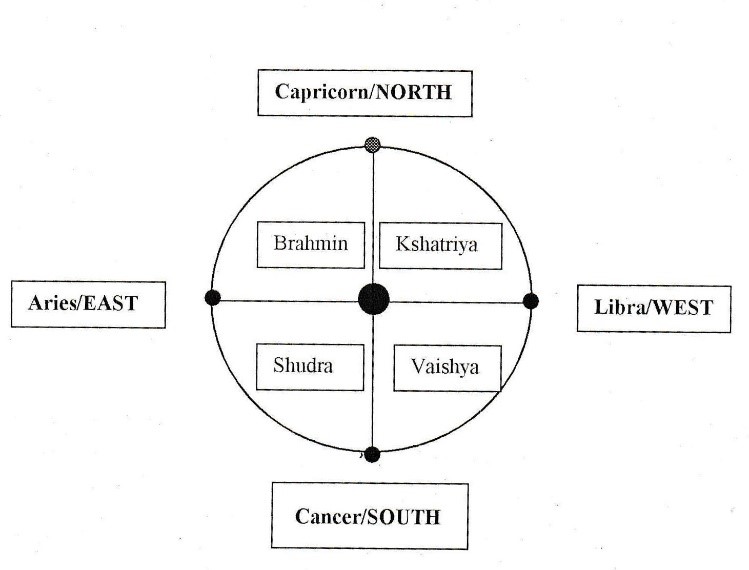
We are burdened today with a consciousness and a vision that supports the hierarchal model, below; just the opposite of that enjoyed by the Vedic society.

The lowest have access only through the upper divisions of castes, and live in a subjugation determined by rank. The shift from the circle to the triangle describes the state of decline, over many generations, when the cosmic key is lost, when ‘a great sleep‘ descended across the entire globe, East as well as West’ (Thea, The Third Way on Conscious Evolution, and Thea, Origin and Nature of Hindu Decline, op cit).
A split began to harden between science and spirituality in the early years of our Piscean Age (234 BCE – 1926 AD) and the Rishis vision of the cosmic harmonies suffered a great decline. This was coupled with the rise of Buddhism, which slowly over a period of generations influenced many schools of thought by ‘undermining’ the Vedic way.
Spiritual seekers were encouraged to find ways to escape Earth’s suffering and impermanence, and the focus shifted away from the Earth’s dynamic fourfold cosmic harmonies. (Thea, Cosmology Old and New, 2009). A deep conflict overtook the Indian nation, depleting its energies, leading eventually to a complete split between spirit and matter.
Thea’s Indocentric Cosmology supports the view that the Veda continues to be the bedrock of Indian spirituality, and it must be preserved for the survival of the planet and its people. The fact that ’Castism’ is arising so violently now is expected. Our Earth entered the Age of Aquarius (Mitra/’friend’) in 1926, and there is a pressure to regain that sense of wholeness, to move toward a ‘universalisation’.
The problem of ‘Castism’ is a ‘seed’ which can open society to a larger lens on life. In that sense this decline in Vedic Wisdom, which spawned the Caste System, is purposeful in the grand plan of evolutionary Time. The whole Earth is meant to inherit the sublime vision of the Rishis; to have the lived experience of the four fold cosmic harmonies, which are imprinted in our genes when we take birth on this 3rd planet of the Solar System.
Part Three - Updating
When a civilisation is built on the eternal cosmic processes, such as the Vedic was, there is an inbuilt mechanism that allows it to escape fossilisation, and encourages new expression to emerge. The Vedic civilisation was characterised by what Thea described as ‘a centre that holds’, an axis which ensured dynamism, change. All castes/all people took the annual journey round the Sun together as a family and this sacred time, called the ‘sacrifice’ was the focus of their lives. At a special time in the journey, the 10th month, they discovered this internal axis, this soul, this zero point, (see Theme 6) by which they found their own place within the whole, Swadharma.
This is true egalitarianism. Difference is acknowledged but no priesthood or authority stood at the pinnacle or had the capacity to deny the other. All four castes had ‘direct access to the Light’, all four parts of the caste system converged onto a single binding Point, to a God-realisation – into a Central Seed, the immanent Transcendent in the heart of all created things, Hiranyaretas.
‘To move into this ‘Golden Seed’,’ rather than out was the purpose of life on Earth. Renouncing the world, dissolution of this ‘Light’ in favor of an ‘afterlife’, or ‘a heaven beyond’ is not the original aim of Chaturvarna’ (Thea, Caste and Culture op cit). The triangular model of caste could only emerge because of a decline in the Vedic way, it is a rejection of the soul, a denial of ‘the land of our birth’, our Solar System. When the Earth and created matter were called ‘illusion’, our Earth became an orphan child. When the Brahmin could no longer read the cosmic harmonies correctly, it was only a matter of time before the Sacred System of Caste degenerated into ‘Castism’ and became an empty and meaningless form, subject to abuse and decay (ibid).
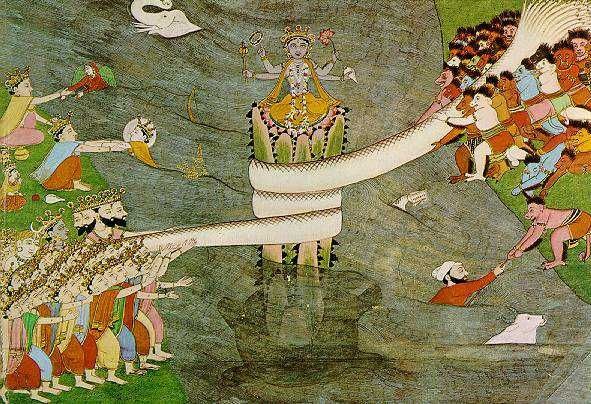
The Power Of The Axis
Comments
References: Chaturvarna in the Veda and the Circle

Thea, Culture and Cosmos – 2, Part 3.1, Cosmic Harmonies in Hindu Civilization and Society, Volume 6 No 3, August 1991.
‘Essential to an understanding of how this degeneration came to pass is the question of exactly what was lost in the vision and expression of the Chaturvarna… no historian or authority on Hindu civilisation has really been able to pinpoint this failing. Indeed, had it been possible to do so, the decline would have been arrested and the aspired reestablishment of the Dharma would have already taken place. Therefore, a fundamental, central feature of this analysis is that lost element in the perception which alone could hold the system together. This was the all-embracing vision of the Cosmic Truth which in ancient times provided the unifying factor. All expressions of the Dharma could be found related to that Cosmic Truth – or the true perception of the cosmic harmony, and, above all, its divine Maya or Measure, as the means to give effective expression in the society to that Truth…’

Thea, Culture and Cosmos – 2, Part 3.2, Cosmic Harmonies in Hindu Civilization and Society, Volume 6 No 4, October 1991.
Thea continues the above article on ‘the uniqueness of the Indian Nationalism’ by describing Mother India as ‘a creation on Earth of the Cosmic Truth, or more precisely, it is a portion of the Earth upon and through which that Truth is given physical consciousness expression…’ . This is the basis for Caste as seen by the Ancient Fathers, and described in the Veda.
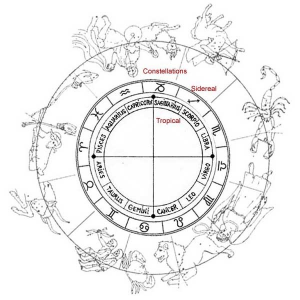
Thea, The Origins and Nature of Hindu Decline, Part 1- 4, 28 November to 13 December 2006.
The ancient text, The Brihat Sumitra, proves that the Constellations were not to be confused with the Tropical Zodiac which never varies in time and whose 12-month segments of the year are inseparable from the solstices and equinoxes. 500 years after Varahamihira’s time, Al Biruni came to India and injected doubt into the minds of the pundits who thought he was more ‘scientifically correct’. This important article explores the consequences of that shift on modern Temple timings; the Makar Sankranti is being celebrated in India 23 days after the 21/22 December solstice.
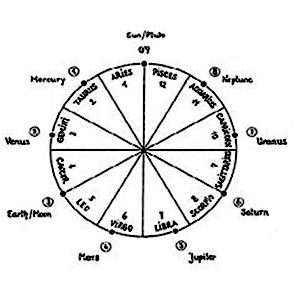
Thea, THE THIRD WAY on Conscious Evolution, 30 June 2004.
A Great Sleep moved across the globe centuries ago, Thea explains; it overtook the East as well as West. Wisemen understood what was to come and they did their best to preserve the WORD. In the East the compilation became known as the Veda; in the West, the preservation, for reasons unknown, were in stone. ‘The mysterious sphinx was installed as a companion to the mighty Pyramid; it was necessary to leave a sample of the language of the celestial harmonies…’

Thea, Cosmology, Old and New, 17 November 2009.
Thea follows the evolution of cosmology from ancient times, in search of keys for renewal and application today. There is a difference between the cosmology of the Rig Veda and the ‘scientific brand of cosmology’ – the central focus in the former is on the ‘human element and the development of a superior consciousness in harmony with the cosmos’. Thea presents the cosmological reasons for the slow and purposeful ‘unravelling’ over the Ages of time of that Rig Vedic cosmology, which has resulted in ‘the great divide’ between matter and spirit.
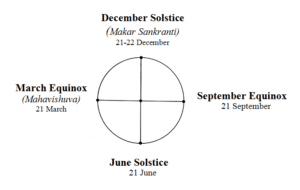
Thea, Caste, Calendar and Cosmos – their interconnection and relevance for contemporary society Part 1, 2003.
The Indian civilisation is considered the oldest in the world, the only living culture with an uninterrupted link to antiquity. It is also believed to have a cosmic connection which still forms the basis of the contemporary culture. The caste system stems from that ancient thread, it arose from that cosmic vision. Today we are burdened with a system that is now an empty form because the ability to read the harmonies is fast disappearing. Part One of this series presents the basics science of the Solar System and the four Cardinal Poles and their Equinoxes and Solstices.

Thea, Caste, Calendar and Cosmos – Part 2, 2003
‘The Cosmic Purush in a circle would be similar to the ancient Ouroboros, the serpent biting its tail, representing precisely the ceaselessness of cyclic time. Its head and tail join at the location in the zodiac of the Zero Point or ayanamsha where the first sign Aries meets the last, Pisces. In this figure, as in the variations on the same circle presented in this treatment, the outstanding characteristic is that these months/signs ‘effortlessly move one into the another’, as the Rig Veda pointedly states to drive home the fact of a unified progression, a perception that is lost on most contemporary astrologers, especially in India. We are dealing with a continuous uninterrupted flow (of time) which Ouroboros depicts so clearly. As demonstrated in the course of this treatment, there are many symbols that have been handed down to us from ancient times, each one presenting the same vision of unity in one form or another.

Thea, Caste, Calendar and Cosmos, Part Three (2003)
‘We are living the collapse of the old – but we are also part of the new that is concurrently arising to replace the old. Cosmos, caste and calendar play fundamental roles in this transition to wholeness, particularly in India, the nation that has never severed those connections. The cosmic harmonies formed the foundation in ancient times for the subcontinental civilisation to carry the burden of the evolution through darkness into an age when the Vishnu Avatar re-appears to lay the guidelines of a new creation of Light.

Culture and Cosmos – 2, Part 3.3, Cosmic Harmonies in Hindu Civilsation and Society, The Vishaal Newsletter Volume 6 No 3, August 1991.
How did the degeneration of caste (chaturvarna) come to pass in this great civilization of India? Any analysis of the problem has to go back and find out the central element that was lost and that held the system together. In this series, Thea identifies that lost element or that unifying factor as the ‘all embracing vision of the cosmic Truth’ upon which the Dharma was founded.

Caste and Culture, The Vishaal Newsletter, Volume 6, No 4, October 1991.
Thea continues the above article with a focus on the long-enduring civilization that is ‘Mother India’. The uniqueness of Indian ‘Nationalism’ is that it has been and continues to be a place on this Earth which gives an actual physical expression to the Truth Consciousness. This is the basis for Caste as seen by the Ancient Fathers, and described in the Veda.
